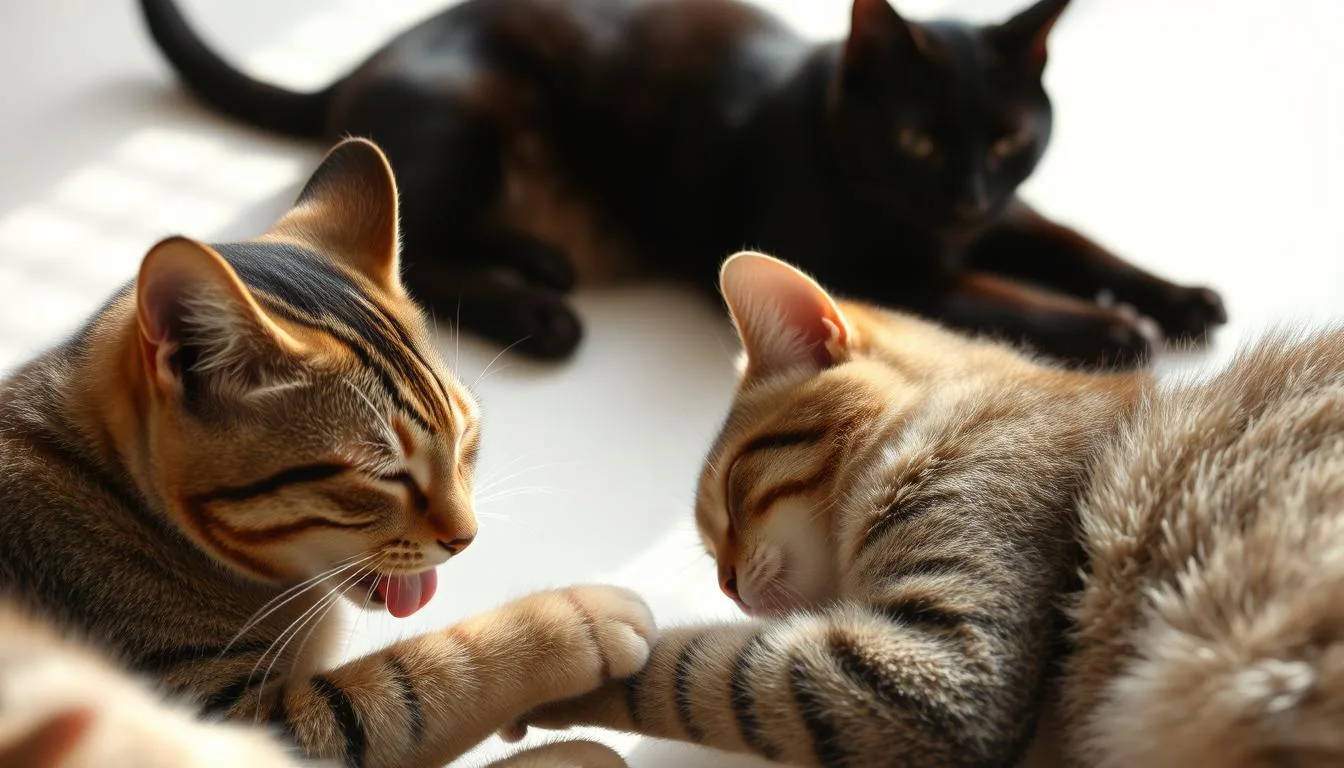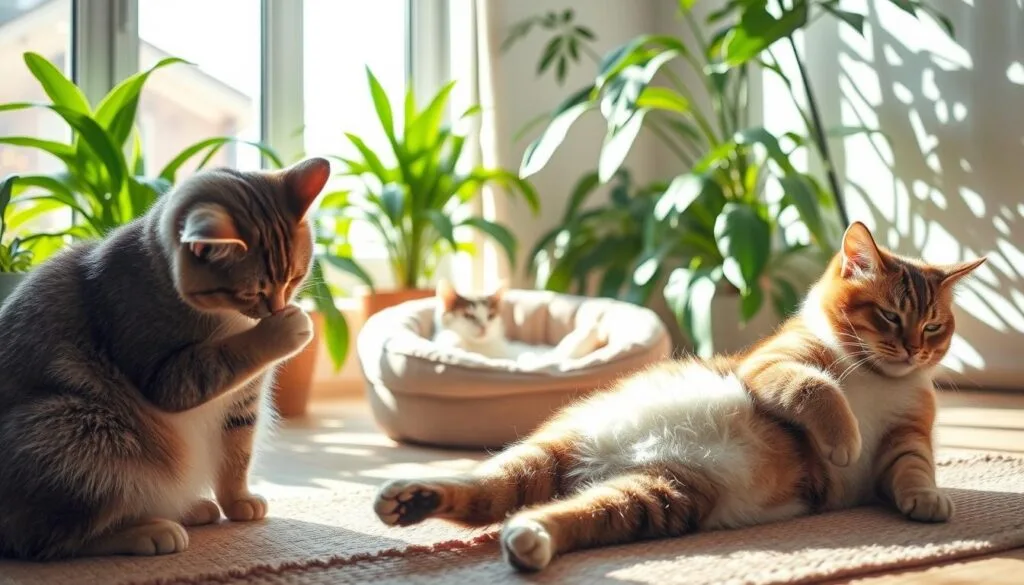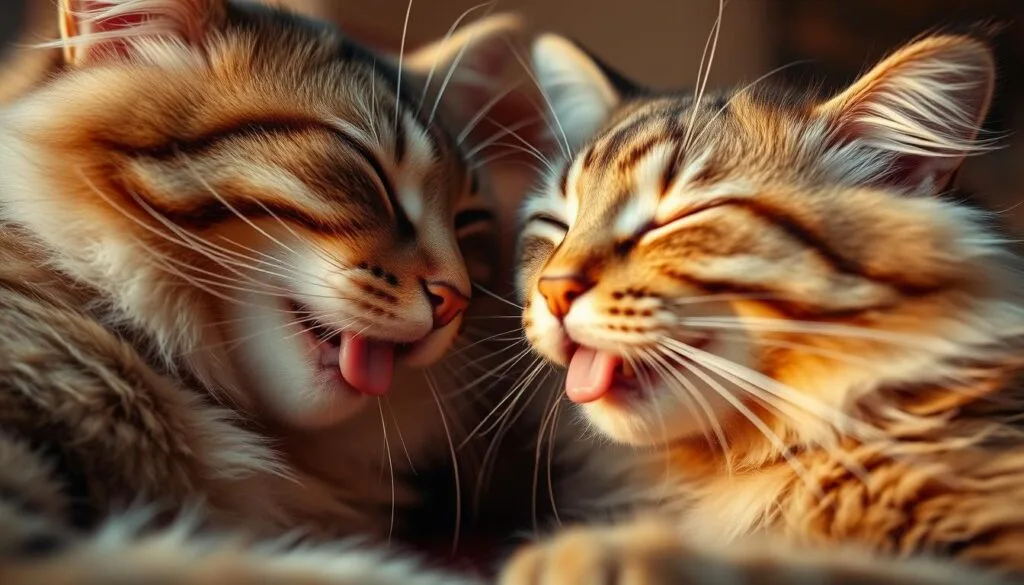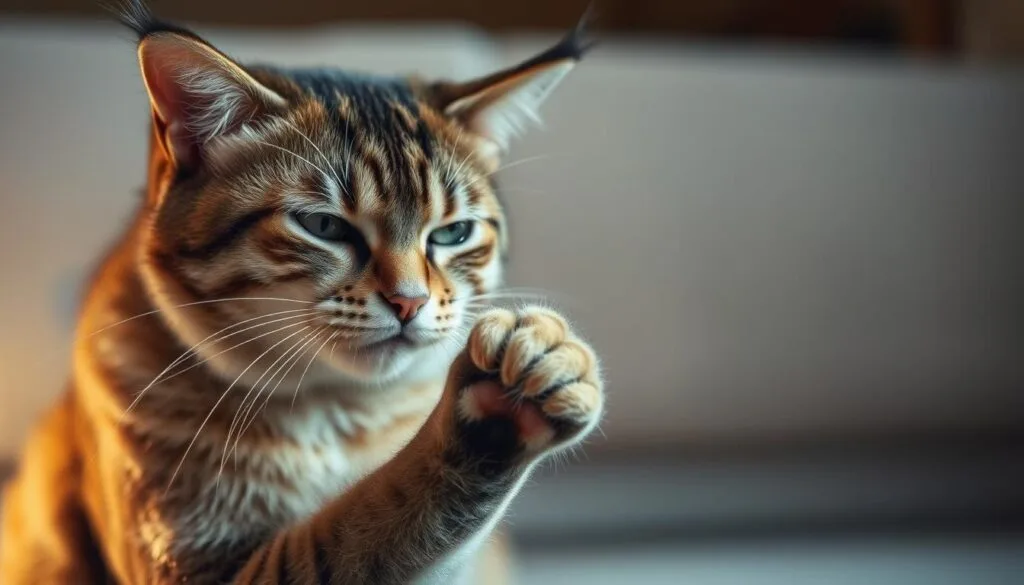
Table of Contents
Ever wondered why cats groom themselves so much? What secrets do they hide in their cleaning rituals? Cats groom themselves as a key survival and self-care act. It’s more than just staying clean.
Cats spend up to 50 percent of their awake time grooming. Unlike others, they groom with a precision that’s almost obsessive. This serves many purposes, like keeping clean, regulating body temperature, and managing stress.
Learning about cat grooming can give us a lot of insight into their health and feelings. Their grooming is not random. It’s a survival instinct they learn as kittens through watching and practicing.
In this guide, we’ll dive into the world of cat grooming. We’ll explore the science, techniques, and importance of this daily ritual. It keeps our feline friends healthy, clean, and emotionally balanced.
The Science Behind Cat Grooming Behavior
Cats groom themselves in a fascinating way that’s more than just keeping clean. Their grooming is rooted in instinct and is vital for their health and survival.
When cats groom, they use complex biological processes to protect themselves. This behavior is not just about staying clean. It’s a smart survival tactic.
Understanding the Feline Grooming Instinct
The grooming instinct in cats is part of their genes. They groom to:
- Regulate body temperature
- Distribute natural oils across their coat
- Remove parasites and dirt
- Reduce stress and anxiety
The Role of Sebaceous Glands
Sebaceous glands are key in cats’ grooming. These glands make sebum, an oily substance that keeps their fur healthy. Each hair follicle has these glands, ensuring their coat stays in top shape.
| Gland Type | Function | Location |
|---|---|---|
| Sebaceous Glands | Produce protective oil | Base of each hair follicle |
| Scent Glands | Mark territory | Cheeks, paws, tail base |
Anatomical Features That Aid in Grooming
A cat’s body is made for grooming itself. Their flexible spine, rough tongue, and nimble paws help them groom well.
“Cats are nature’s perfect self-cleaning machines” – Veterinary Grooming Experts
How Cats Groom Themselves: The Natural Process
Cats groom themselves with great care and precision. Their self-cleaning routine shows their natural instinct and attention to detail. They make sure to clean every part of their body.
The grooming starts with their face and head. They use their dampened forepaw to clean their face, ears, and head. They switch paws to clean every area well. This wet-paw technique helps them reach hard-to-clean spots.
- Start with face and head cleaning
- Use dampened forepaw for wiping
- Rotate paws for comprehensive coverage
- Lick paw to re-moisten for continued cleaning
Cats groom themselves for more than just cleanliness. They also spread natural oils, remove loose fur, and keep warm. Each stroke has many benefits, from keeping them clean to signaling to other cats. The licking also helps their blood flow and relaxes them.
Knowing how cats groom themselves helps us understand their self-care. Cats groom not just for cleanliness but for their physical and emotional health.
The Barbed Tongue: Nature’s Perfect Grooming Tool
Cats groom themselves with amazing precision. Their secret is their unique tongue. This natural tool is more complex than you think, making everyday cleaning a detailed process.
Cats groom themselves with a design perfected by evolution. Their tongues have tiny backward-facing barbs called papillae. These act like a built-in comb and brush.
Structure of Tongue Papillae
The papillae on a cat’s tongue are made of keratin, the same as human hair and nails. These tiny structures make the tongue rough. They serve many grooming purposes:
- Removing loose fur and debris
- Detangling matted hair
- Distributing natural skin oils
- Stimulating blood circulation
How Tongue Barbs Help in Coat Maintenance
These special barbs work like tiny brushes. They help cats groom themselves efficiently. When a cat licks its fur, the papillae:
- Capture and remove dirt particles
- Untangle knots in the fur
- Spread protective oils across the coat
- Regulate body temperature
With this clever design, cats keep themselves clean, comfortable, and healthy. They use a tool that’s both simple and complex.
The Daily Grooming Ritual of Cats

Cats groom themselves in a fascinating way. They have a precise routine that shows their natural cleanliness. Each cat has its own way of staying clean, but they all follow a similar pattern.
They start their grooming with a specific order. This ensures they clean themselves thoroughly. Their grooming involves several important steps:
- Face and whisker cleaning
- Shoulder and foreleg washing
- Flank and body coverage
- Hind leg maintenance
- Tail grooming from tip to base
They groom themselves many times a day. Cats spend about 30-50% of their awake time cleaning themselves. This isn’t just for looks. It helps them stay cool, relax, and bond with others.
“A cat’s grooming ritual is more than cleanliness—it’s a complex behavior deeply rooted in survival instincts.” – Veterinary Behavioral Specialist
Your cat’s grooming habits might differ. They depend on the cat’s personality, breed, and surroundings. Some cats groom more when it’s quiet. Others do quick cleanings all day long.
Knowing about these habits helps you see how special feline self-care is. It also lets you notice if your cat’s grooming shows health issues.
From Head to Tail: A Cat’s Grooming Pattern
Cats groom themselves with great care and detail. Their grooming is a complex process that keeps them clean and healthy. It shows how cats take care of themselves.
Feline grooming covers every part of their body. Cats use different methods for each area they clean.
Face and Whiskers Cleaning Technique
Cats have a special way to clean their face. They lick their paw and then rub it over their face and whiskers. This acts like a natural washcloth, reaching delicate areas around their eyes and ears.
- Cats use their right or left paw for face cleaning
- They wet the paw with saliva before wiping
- Multiple passes ensure thorough cleaning
Body and Limb Grooming Sequence
Body grooming is more detailed. Cats use their tongue to remove dirt, loose fur, and parasites. They start at their shoulders and work down, making sure to cover everything.
- Begin at the shoulders
- Move down the back
- Clean each limb carefully
- Reach hard-to-access areas
Tail Maintenance Methods
Tail grooming is special because it requires flexibility. Cats twist and turn to clean every part of their tail. They use their tongue to smooth and clean the fur, keeping the tail healthy and sleek.
Knowing these grooming patterns helps us see how much cats care for themselves.
Temperature Regulation Through Grooming

Cats groom themselves in a way that’s more than just keeping clean. Their grooming helps manage their body temperature, especially when it’s hot.
When cats groom, they use saliva to cool down. This is a clever biological trick that helps them stay at the right temperature. Unlike dogs, cats don’t cool down by panting.
- Saliva spreads across their fur during grooming
- Evaporation creates a cooling effect on their skin
- This method helps regulate body temperature efficiently
Cats groom themselves by spreading moisture. As the saliva dries, it cools them down, like how sweat cools humans. This is a great way for cats to stay cool in warm places.
“A cat’s grooming is more than vanity—it’s survival science.” – Veterinary Thermal Regulation Expert
| Cooling Method | Effectiveness | Energy Expenditure |
|---|---|---|
| Cat Grooming | High | Low |
| Dog Panting | Moderate | High |
Learning about how cats groom shows their amazing adaptability. Their grooming is not just for cleanliness. It’s a smart way to keep their body temperature right.
Social Aspects of Feline Grooming
Cats groom themselves for more than just cleanliness. It’s a powerful way to communicate socially. In the world of cats, grooming is a complex language of connection and trust.
Understanding cat grooming reveals interesting insights into their social lives. Cats groom each other as a way to build and keep relationships strong within their groups.
Allogrooming: A Social Ritual
Allogrooming is when cats groom themselves and each other. It creates strong social bonds. This behavior is more than just keeping clean. It has several important social roles:
- Establishing hierarchy within cat groups
- Expressing friendship and acceptance
- Reducing social tension
- Sharing group scent
Bonding Through Mutual Care
When cats groom themselves or others, they’re doing more than cleaning. Mutual grooming is a deep form of communication and emotional connection. It shows trust and intimacy.
Cats may also groom their human friends. This is a sign of affection and acceptance in the feline world.
When Grooming Becomes Stress Relief
Cats groom themselves for more than just cleanliness. It’s a strong way to cope with emotions. When they feel anxious or stressed, grooming becomes a calming ritual.
Displacement grooming is a unique way cats calm down. They use their grooming instincts to soothe themselves in stressful times. This helps them manage their feelings and ease tension.
- Grooming releases endorphins that help cats feel relaxed
- Excessive licking can signal underlying emotional distress
- Stress triggers may include changes in environment or routine
Excessive grooming can mean a cat is anxious. Signs of stress include:
| Stress Trigger | Grooming Response |
|---|---|
| New Pet Introduction | Increased self-grooming |
| Household Changes | Compulsive licking |
| Loud Noises | Repetitive grooming patterns |
Knowing these signs can help you support your cat’s emotional health. It also tells you when they might need professional help.
Signs Your Cat Needs Help With Grooming
Cats groom themselves, but sometimes they need extra help. Knowing when your cat needs grooming is key for their health and happiness.
As cats get older or face health issues, grooming can become harder. Spotting when your cat needs grooming help is vital for their comfort and cleanliness.
Age-Related Grooming Challenges
Older cats find grooming tough due to physical issues. Arthritis and stiff joints make it hard for them to groom all over.
- Decreased mobility limits grooming capabilities
- Stiff joints prevent thorough coat maintenance
- Reduced flexibility impacts overall cleanliness
Health Conditions Impacting Grooming
Some health problems make grooming hard for cats. Obesity, chronic illnesses, and physical disabilities often need extra grooming help.
| Health Condition | Grooming Impact | Recommended Action |
|---|---|---|
| Obesity | Limited reach and flexibility | Regular brushing and professional grooming |
| Arthritis | Reduced self-cleaning ability | Gentle assisted grooming |
| Skin Conditions | Potential grooming discomfort | Veterinary consultation |
Look for signs like matted fur, unkempt appearance, or visible difficulty moving during grooming. These signs mean your cat might need more grooming support to stay healthy and comfortable.
Overgrooming: When to Be Concerned

Cats groom themselves naturally, but sometimes they do it too much. Overgrooming happens when a cat licks, bites, or chews their fur too much. This can harm their coat and skin.
It’s important to know when your cat is overgrooming. Look out for signs like:
- Patches of missing fur
- Skin irritation or redness
- Wet or matted areas on the coat
- Constant licking of specific body parts
Many things can make a cat overgroom. Emotional and physical stressors can upset their grooming routine.
| Potential Causes | Possible Triggers |
|---|---|
| Psychological Factors | Anxiety, recent home changes, new pets |
| Medical Conditions | Allergies, skin infections, parasites |
| Environmental Stressors | Loud noises, territorial conflicts |
If your cat keeps overgrooming, see a vet. They can find out why and help your cat groom properly again.
Supporting Your Cat’s Grooming Needs
Cats groom themselves, but sometimes they need extra help. Knowing how to support their grooming can prevent health problems and strengthen your bond.
Caring for your cat’s grooming needs is more than just brushing sometimes. Each cat is different, needing unique care based on their coat, age, and health.
Essential Brushing Techniques
Choosing the right brushing technique is key when helping cats groom. Different coat types need different approaches:
- Short-haired cats: Use a soft-bristled brush weekly
- Long-haired cats: Brush daily to prevent matting
- Senior cats: Use gentle, short strokes
- Cats with skin sensitivities: Choose soft, flexible brushes
Recommended Grooming Tools
| Coat Type | Recommended Tool | Brushing Frequency |
|---|---|---|
| Short Hair | Rubber Grooming Mitt | Weekly |
| Medium Hair | Slicker Brush | 2-3 Times Weekly |
| Long Hair | Metal Comb | Daily |
Professional Grooming Options
Sometimes, professional grooming is needed. Think about it if your cat has:
- Severe matting
- Skin conditions
- Limited mobility
- Excessive shedding
“A well-groomed cat is a healthy cat.” – Veterinary Professionals
Professional groomers can do deep cleaning, haircuts, and tackle coat challenges that are hard to handle at home.
Understanding Displacement Grooming Behavior
Cats groom themselves in many fascinating ways. Sometimes, their grooming is more than just keeping clean. Displacement grooming shows deep insights into your cat’s emotional state.
When cats face conflicting emotions or stressful situations, they groom as a coping mechanism. This behavior helps them manage tension by focusing on a familiar action.
- Triggers for displacement grooming include:
- Sudden environmental changes
- Unexpected loud noises
- Confrontations with other animals
- Unfamiliar human interactions
Recognizing displacement grooming helps you understand your cat’s stress levels. Excessive licking, sudden grooming during tense moments, or grooming in unusual contexts show emotional turmoil.
“Cats groom themselves not just for cleanliness, but as a complex emotional language.” – Feline Behavior Specialist
| Behavior Type | Emotional Indication | Typical Response |
|---|---|---|
| Brief Licking | Mild Stress | Temporary Distraction |
| Prolonged Grooming | High Anxiety | Self-Soothing Mechanism |
| Sudden Grooming | Conflict Avoidance | Emotional Reset |
By watching your cat’s grooming, you can support their emotional well-being. This helps create a more comfortable environment for them.
The Connection Between Grooming and Health
Cats groom themselves as a natural instinct. Their grooming habits can reveal crucial information about their health. Understanding these signals helps you become a more attentive pet owner and catch potential health issues early.
Your cat’s grooming patterns serve as a vital health barometer. Subtle changes in their routine can indicate underlying medical conditions that might require professional attention.
- Excessive grooming might signal skin allergies
- Reduced grooming could indicate pain or mobility issues
- Patchy fur can suggest metabolic disorders
- Sudden grooming changes warrant veterinary consultation
Veterinarians often use grooming behavior as a diagnostic tool. Cats groom themselves meticulously, so any deviation from their normal routine can be a red flag for potential health problems.
| Grooming Behavior | Potential Health Indication |
|---|---|
| Decreased Grooming | Arthritis, Depression, Dental Pain |
| Excessive Grooming | Skin Infections, Anxiety, Parasites |
| Uneven Coat | Thyroid Issues, Kidney Disease |
By paying close attention to how cats groom themselves, you can become proactive about your pet’s health. Regular observation combined with routine veterinary check-ups ensures your feline companion stays healthy and happy.
Conclusion
Cats groom themselves with amazing precision and purpose. Their grooming is more than just keeping clean. It’s a way to keep their body and mind in balance.
Knowing how cats groom helps you see when they might need help. Even though most cats groom themselves, some health issues or aging can make it hard. Watching them and sometimes helping can keep them healthy and happy.
Understanding feline grooming makes you a better pet owner. Seeing how your cat grooms can tell you a lot about their health. It lets you help when needed and enjoy their self-care skills.
Every cat is different in how they groom. But, grooming is key for their health and happiness. Your job is to support their grooming and help gently when needed.
FAQ
Why do cats spend so much time grooming themselves?
Cats groom themselves for many reasons. They keep their coats healthy, control their body temperature, and get rid of dirt and parasites. It’s also a way for them to handle stress and feel good emotionally.
How often do cats typically groom themselves?
Cats groom themselves a lot, often 30-50% of their day. This can change based on their age, health, and personality.
What makes a cat’s tongue so special for grooming?
A cat’s tongue has special backward-facing barbs. These act like a comb, removing dirt and parasites. This makes cats very good at grooming themselves and keeping their coats clean.
Can excessive grooming be a sign of a health problem?
Yes, too much grooming can mean health issues like skin allergies or stress. If your cat is grooming too much or losing hair, see a vet.
Do all cats groom themselves equally?
No, grooming habits differ. Age, breed, health, and personality all play a part. Some cats, like older or obese ones, might need help grooming.
Is cat grooming only about cleaning?
Grooming is more than cleaning. It helps with temperature control, stress relief, and social bonding. It’s also a way for cats to feel comfortable and communicate.
How can I help my cat with grooming?
You can help by brushing your cat’s coat and using the right grooming tools. Assist with hard-to-reach spots and watch for any grooming problems.
Why do cats groom each other?
Allogrooming is a way for cats to bond and show love. It helps them clean each other and is a sign of trust and friendship in cat groups.







